![]()
 FO-07664
FO-07664
2005
![]()
The Japanese beetle is a serious pest of turf and ornamental plants. Grubs feed on the roots of turfgrass and adults feed on the foliage of more than 300 plant species.
A good treatment program consists of identifying grubs to species, determining grub numbers, identifying thresholds, timing pesticide application to the vulnerable stage of the grub, and monitoring the treated area for results, since additional pesticide applications may be necessary. Japanese beetle needs to be monitored and controlled in nursery commodities, golf courses, recreational fields, and home lawns. This is necessary to minimize damage to turf or nursery plants, prevent beetle spread to other areas, and maintain the opportunity to sell nursery products to all markets.
Japanese beetle adults are approximately 3/8 inches in length. The front of the beetle is dark metallic green. Its wing covers are a metallic dark tan.
The beetle has two small patches of short white hairs on its rear, and five white hair tufts along each side of the dorsal abdomen. These patches are key characteristics for identification. If it does not have these patches, but has the other color traits, then it may be the false Japanese beetle (Figure 1).
Figure 1. Adult stages of several white grub species.
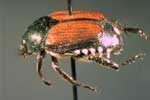 adult Japanese beetle Popillia japonica Japanese beetles have five tufts of white hair along the wing margin. |
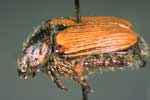 adult False Japanese beetle Strigoderma arbicola False Japanese beetles lack the five white hair tufts along wing margin. |
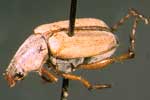 rose chafer Macrodactylus subspinosus |
 May/June beetle Phyllophaga species |
 masked chafer Cyclocephala borealis |
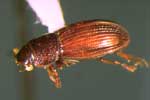 black turfgrass Ataenius Ataenius spretulus |
The larval or grub stage of the Japanese beetle is a "C" shaped white grub that lives in the soil. Its primary food source is grass roots, but it is known to feed on the roots of corn, beans, tomatoes, and strawberries. All "white grub" species are similar looking but vary in their life cycles, so identifying the grub to species is important for the proper timing of pesticide application.
Grubs can be identified to species by the pattern of hairs on their brown hind ends (raster). Using a 10-power hand lens, you can see that the hairs on the raster of Japanese beetle form a small "V" shape just below the anal slit (Figure 2).
Figure 2. Grub rastral patterns are used for identification. The hind end of the grub, its raster, contains sutures and hairs used to identify the species. Clockwise from top are rasters of Japanese beetle, masked chafer, May/June beetle, and black turfgrass Ataenius.
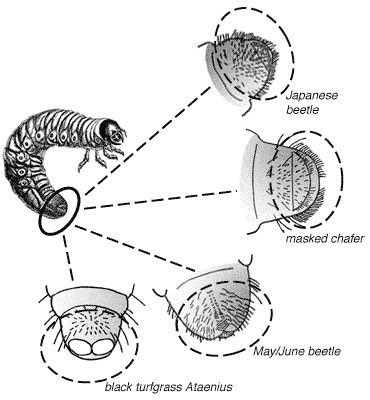
Grub populations between 7 and 15 per square foot can cause significant damage to non-irrigated turf. Irrigated turf can withstand a higher grub count because the increase in water compensates for the roots chewed off by the grub.
Grubs chew off grass roots and reduce the ability of grass to take up enough water to withstand stresses of hot, dry weather. As a result, large dead patches of grass develop in grub infested areas. The sod on these dead patches can be rolled back like a carpet to expose the grubs and the lack of turf roots. Early recognition of the problem can prevent this destruction.
When grubs are close to the surface, starlings and crows, as well as moles, shrews, and skunks may be seen digging up grubs, also damaging the turf.
Timing of pesticide treatment is important. Larger grubs are more difficult to control with insecticides, and the grubs are difficult to kill in the fall because they are larger. Preventative chemicals should be applied early, May through July, when eggs are first hatching and the grubs beginning to feed. Rescue treatments should be used in August and September. Treating grubs in the spring is also more difficult as they are bigger and do not feed for long before they pupate (Figure 3).
Figure 3. Life cycle of Japanese beetle: egg, grub, and adult stages. In June, the grub turns into a pupa. It emerges from the soil in late June and July as an adult, to mate and lay eggs. Females live for a few weeks feeding on trees, shrubs and roses in the morning, returning to the turf in the afternoon to lay more eggs. Eggs hatch in July and grubs are almost full grown by late August. Grubs dig deep in the soil for the winter months and then move upward in spring as the soil warms. Grubs do best in warm, slightly moist soil that has plenty of organic matter and tender grasses. However, they can survive in almost any soil.
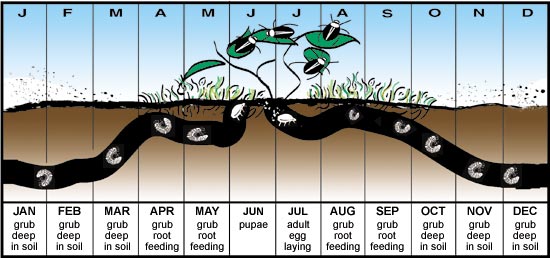
Insecticides are needed to control grubs, but repeated applications may be necessary because of the relatively short residual effect of the pesticides. Also, cautions about their use must be observed. (See Tables 1a and 1b, and the summary of pesticides.)
| common name | trade name | use for | class | comment/cautions |
|---|---|---|---|---|
| bifenthrin | Talstar | adults | pyrethroid | High toxicity to honeybees, birds, fish. Do not use nearer than 100 yards from water. |
| carbaryl | Sevin | grubs, adults | carbamate | High toxicity to bees, earthworms; moderately toxic to birds, fish. Do not use adjacent to water. Available for homeowner use. |
| chlorpyrifos | Dursban | grubs, adults | organophosphate | High toxicity to birds, fish. Available only to licensed applicator. |
| cyfluthrin | Tempo | adults | pyrethroid | High toxicity to birds, fish. Do not use adjacent to water. |
| deltamethrin | DeltaGard | adults | pyrethroid | High toxicity to birds, fish. Do not use adjacent to water. |
| ethoprop | Mocap | grubs | organophosphate | Toxic to aquatic organisms and wildlife. |
| halofenozide | Mach2, GrubEX | grubs | diacylhydrazine | Low toxicity to birds, fish. Insect growth regulator. Available for homeowner use. |
| imidacloprid | Merit | grubs | chloronicotinyl | Low toxicity to birds, fish. Do not use after August 15, instead use diazinon, ethoprop, trichlorfon. Available for homeowner use. |
| lambda-cyhalothrin | Scimitar, Battle | grubs | pyrethroid | High toxicity to fish. |
| malathion | Malathion | adults | organophosphate | High toxicity to honeybees. Odor may be a problem in public places. |
| permethrin | Astro | grubs, adults | pyrethroid | High toxicity to fish, bees. For home lawns only. |
| trichlorfon | Dylox | grubs | organophosphate | High toxicity to birds, fish. Do not use nearer than 100 yards from water. Available for homeowner use. |
| common name | trade name | class | comment |
|---|---|---|---|
| bifenthrin | Talstar | pyrethroid | Use in potting media. |
| imidacloprid | Marathon | chloronicotinyl | For use in containers. |
| telfluthrin | Fireban | pyrethroid | Use in potting media for harmonization plan. |
Irrigating after applying an insecticide improves its insect control, though a significant rainfall shortly after the application may reduce the insecticide';s concentration below effective levels. A one-inch or thicker layer of thatch may absorb the insecticide before it can reach the layer of soil where the grub is feeding, also making it ineffective.
Infestations should be checked one week after an insecticide is applied, especially if the original grub population was high.
Imidacloprid -- is not fast acting, so use as a preventative control, not as a rescue treatment. Apply imidacloprid between May 15 and August 15. It has minimal risk to birds and fish.
Ethoprop -- can be used as a rescue treatment when damage is observed.
Halofenzide -- is not fast acting, so use as a preventative control, not as a rescue treatment. It mimics an insect hormone and is best applied when adults are active and laying eggs from June to the beginning of August. Minimize thatch since heavy thatch will prevent the insecticide from penetrating to the area where insects are feeding.
Trichlorfon -- is fast-acting, but susceptible to alkaline hydrolysis. It degrades very rapidly in very hard or alkaline water or in a high pH soil. Half of the active ingredients will be degraded in 30 minutes at a pH of 9. Do not lime your lawn just before or after treatment for the same reason. Trichlorfon can be used as a rescue treatment when damage is observed.
Chlorpyrifos -- can be effective against grubs, but is generally not considered a top choice due to the high binding ability of the active ingredient to the thatch. It is a good choice for adult Japanese beetle control.
Milky spore disease -- is caused by the bacteria Bacillus popilliae and is sold under the names of Japidemic Doom and Milky Spore. Recent trials with these formulations have not reduced Japanese beetle grub numbers in turf.
Insecticides may be used to control adult Japanese beetles, but repeated applications may be necessary because some pesticides have relatively short residual effects. A significant rainfall shortly after an application may reduce the insecticide concentration below effective levels (Table 1a).
Use an ecosystem approach to managing Japanese beetles. Carefully select plant species that Japanese beetle adults do not like to feed on, when adding to your landscape or golf course. Certain common landscape plants are inevitably attacked and may be poor landscape choices (Table 2). The nursery industry can reduce Japanese beetle numbers in cultivated areas or containers by eliminating grasses that the grubs feed upon.
|
avoid |
better choice |
|||
|---|---|---|---|---|
|
American chestnut American elm American linden American mountain ash apple black cherry black walnut cherry |
flowering crabapple grapes gray birch hollyhock horse chestnut Norway Maple plum roses |
American elder arborviate black oak boxelder common lilac euomymus (all species) fir green ash |
hemlock holly (all species) juniper pine red maple red oak rhododendron scarlet oak |
silver maple spruce white ash white oak white poplar yew |
|
|
||||
Bloetscher, B. et al. 2001. Management of turfgrass pests, weeds, diseases, and insects. Ohio State University Extension Bulletin L-187.
Bradenburg, R. and M. Villani. 1995. Handbook of Turfgrass Insect Pests, Entomological Society of America. 140 pages.
Cranshaw, W. 1997. Turfgrass Insects in Colorado and Northern New Mexico, Colorado State Cooperative Extension, ISBN 1 889143006. 38 pages.
Krischik, V. and M. Ascerno. Revised 2000. Managing Lawn and Turf Insects, University of Minnesota Extension Service, item FO-1008-F. 12 pages.
Villain, M. and H. Tashiro. 2001. Turfgrass Insects of the United States and Canada, Cornell University Press, ISBN 0801418143. 391 pages.
University of Minnesota.
CUES: Center for Urban Ecology and Sustainability
www.entomology.umn.edu/cues
North Carolina State University.
www.turffiles.ncsu.edu/publist.php
Ohio State University.
plantfacts.osu.edu/
University of Kentucky.
www.uky.edu/Agriculture/Entomology/enthp.htm
University of Maryland.
iaa.umd.edu/umturf/umturf.html
This publication was produced in cooperation with the Minnesota Department of Agriculture, and. . .

![]()
Produced by Communication and Educational Technology Services, University of
Minnesota Extension Service.
In accordance with the Americans with Disabilities Act, this material is available in alternative formats upon request. Please contact your University of Minnesota Extension Service office or the Distribution Center at (800) 876-8636.
The University of Minnesota Extension Service is committed to the policy that all persons shall have equal access to its programs, facilities, and employment without regard to race, color, creed, religion, national origin, sex, age, marital status, disability, public assistance status, veteran status, or sexual orientation.